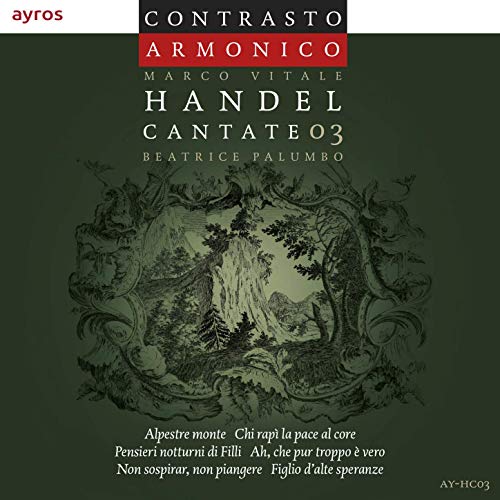HANDEL Cantate 03
View record and artist detailsRecord and Artist Details
Composer or Director: George Frideric Handel
Genre:
Vocal
Label: Ayros
Magazine Review Date: 10/2019
Media Format: CD or Download
Media Runtime: 63
Mastering:
DDD
Catalogue Number: AYHC03

Tracks:
| Composition | Artist Credit |
|---|---|
| Alpestre monte |
George Frideric Handel, Composer
Beatrice Palumbo, Soprano Contrasto Armonico George Frideric Handel, Composer Marco Vitale, Conductor |
| Chi rapi la pace al core? |
George Frideric Handel, Composer
Beatrice Palumbo, Soprano Contrasto Armonico George Frideric Handel, Composer Marco Vitale, Conductor |
| Pensieri notturni di Filli, 'Nel dolce dell'oblio' |
George Frideric Handel, Composer
Beatrice Palumbo, Soprano Contrasto Armonico George Frideric Handel, Composer Marco Vitale, Conductor |
| Ah, che pur troppo è vero |
George Frideric Handel, Composer
Beatrice Palumbo, Soprano Contrasto Armonico George Frideric Handel, Composer Marco Vitale, Conductor |
| Non sospirar, non piangere |
George Frideric Handel, Composer
Beatrice Palumbo, Soprano Contrasto Armonico George Frideric Handel, Composer Marco Vitale, Conductor |
| Figlio d'alte speranze |
George Frideric Handel, Composer
Beatrice Palumbo, Soprano Contrasto Armonico George Frideric Handel, Composer Marco Vitale, Conductor |
Author: David Vickers
Ellen Harris’s perceptive essay suggests that Alpestre monte might have been composed in either Florence or Venice in about 1709. The inconvenient truth is that nobody really knows. Beatrice Palumbo sings with a slightly uneven flutter that nonetheless conveys an appealing emotional vulnerability and poetic sincerity, in dialogue with two violin parts shaded fluently by Enrique Gómez-Cabrero Fernández and Marzeno Biwo. Its opening accompanied recitative describing wild alpine mountains and forests mirroring an unrequited young man’s despair, the first lament containing expressive chromatic dissonances and the sorrowful closing aria conveying hopelessness amid overlapping contrapuntal violins are all interpreted with expressive sensitivity.
The other cantata here to feature a violin is Figlio d’alte speranze. Its narration of the fluctuating fortunes of King Abdolonymus of Sidon makes it the odd one out among poetry that otherwise presents outpourings of suffering lovers. It was written on Venetian paper – but that does not necessarily mean it was composed in or for Venice. We seem to be on firmer ground with Pensieri notturni di Filli, probably created in Rome in 1707 08. This is a spellbinding performance albeit with occasional vocal frailties, offering blissful pastoral conversations between Palumbo and recorder player Romeo Ciuffa.
A puzzling mystery is just how much (or little) Handel composed for Florence. Harris suggests three continuo cantatas here might have Florentine origins: Chi rapì la pace al core, Ah, che pur troppo è vero and Non sospirar, non piangere. Again, nobody knows – but these poignant and articulately shaped performances of some of Handel’s least-known works are rewarding. Palumbo’s limpid singing in the intimate small-scale music is supported elegantly by the continuo duo of cellist Marta Semkiw and Vitale, who plays the florid harpsichord obbligato part in HWV177 with judicious dexterity. The manifold qualities of these seldom-recorded continuo cantatas speak for themselves in these endearing performances.
Discover the world's largest classical music catalogue with Presto Music.

Gramophone Digital Club
- Digital Edition
- Digital Archive
- Reviews Database
- Full website access
From £8.75 / month
Subscribe
Gramophone Full Club
- Print Edition
- Digital Edition
- Digital Archive
- Reviews Database
- Full website access
From £11.00 / month
Subscribe
If you are a library, university or other organisation that would be interested in an institutional subscription to Gramophone please click here for further information.




